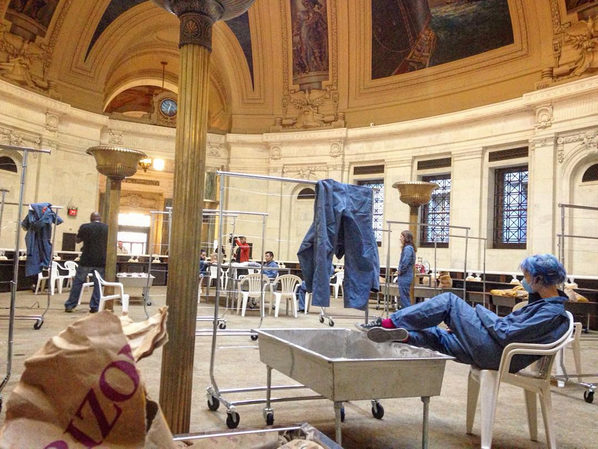Art & Exhibitions
Artist Oscar Murillo Has People Grinding Corn in Lower Manhattan
He's no poster boy for the Zombie Formalists.

He's no poster boy for the Zombie Formalists.

We have to accept, I think, that Oscar Murillo was the wrong pick as a poster boy for the group of hugely successful younger abstractionists pilloried as opportunists, Zombie Formalists (Walter Robinson’s trenchant phrase), or whatever else, suggestive of glib, made-for-market art.
Murillo, a Colombian man under thirty who lives in London, plays with a far more interesting deck of cards than that, as could be clearly seen this week at “Lucky Dip,” his piece for Performa 15 at One, Bowling Green.
The space is beyond striking. There are white marble walls and an exaggerated Dalí-esque lozenge of a roof with WPA-era murals by Reginald Marsh. The floor space has been converted by Murillo into a workroom where people can be seen grinding a South African corn called Mighty White.
A sign over an arched doorway leading out of the central space announced another exhibition area: Ceramica de los Ancestros.
“We visited many buildings,” said Murillo, a slight figure in black, “but none had the same grandeur.” Murillo was speaking about the building, One Bowling Green, which was built by Cass Gilbert (also the architect of the Woolworth Building) and is now the home of both the US Bankruptcy Court and the National Museum of the American Indian.
https://instagram.com/p/-R5P-HwDGC/?tagged=oscarmurillo
On sheets of paper dangling from wires were small paintings that Murillo had made here. Some had Chinese characters on them—the same two characters repeated several times. What did they signify, I asked Murillo.
“I made a trip to China,” he said. There, he was taken to the workshop of an ink master, saw those symbols, and asked just the same question. “They mean ‘Work In Progress,'” he said.
And the social demographics of Work In Progress are very much what Murillo’s conceptual projects are all about. His show at the South London Gallery in 2013 had included a lottery prize draw at a Colombian joint in a mostly working class London neighborhood, the Elephant and Castle, which is a corruption of the Spanish title, the Infanta of Castille—in case you were wondering.
“Lottery tickets are cheap,” Murillo told me at Bowling Green. “I used to buy them.” Did he ever win, I asked. Murillo laughed, signifying no.
He made the tickets expensive, 2,500 pounds sterling each. The winner got a photographic record of a trip to Colombia taken by a ticket vendor and maintenance staff were invited to the opening. It was a fundraiser for the gallery, which pocketed a quarter of a million sterling.
I first met Murillo at the opening of his show “A Mercantile Novel” at David Zwirner’s Chelsea gallery this past year. For this, Murillo’s first Manhattan show, Zwirner constructed a candy factory on the premises, like the one in which Murillo’s mother had formerly worked and flew in a posse of Colombian women to run it. Many snickered that this was cynical, just a cutesy way to sugar-coat the art sales. I am sure that they were wrong.